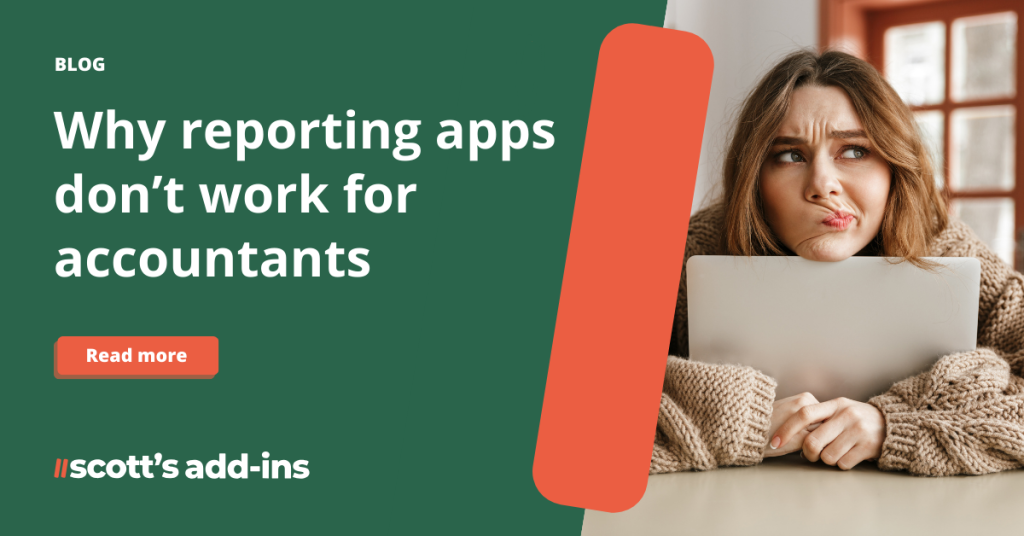Automated reporting sounded great in theory. Digital upheaval to streamline operations, enhance data analysis, and pave the way for a new era of advisory services. So why – a decade and tens of thousands of dollars of VC and subscription money later – are the reports themselves so…meh?
Despite the buzz and the promise, these tools have largely failed to deliver on the core point of reporting. That’s to provide companies with insightful data necessary to make informed decisions. And we’re not even counting the yet-to-crystalize advisory revolution.
At its core, this is a fundamental mistake around the value of reporting and the unique role that accountants play.
Precision, customization, and adaptability are not just nice-to-haves. They’re the heart of the proposition. Cloud reporting apps often spit out colorful, nicely laid-out graphs that tell clients nothing. Call it the emperor’s new spreadsheet.
Your clients deserve better. Your firm’s reputation needs better. Here’s how to get it.
The Failed Reporting Revolution
There is no single template for a business. You can’t automate grand dreams and there’s no formula for varied human and market fluctuations. That’s why reporting has always functioned best as an extension of the conversations that accountants have with their clients every day.
Accountants bring the personal insight and business context to answer questions clients may not have thought to ask yet. And this sets the foundation for the future.
When reporting is considered in its full context, it seems perverse that tech companies thought that one app could deliver the same value. Which is exactly what we have seen laid bare.
The Myth of One-Size-Fits-All
Reporting apps often come with loads of predefined templates and formulas. This universal approach rarely aligns with the diverse and fast changing needs of different businesses. This results in generic reports that either lack specificity or require considerable manual adjustments, negating the efficiency that was the whole point.
Cost Vs. Customization
Reporting platforms are a hefty new line item to client bills and firm overheads. Bills can add up quickly, but the route to monetization and ROI is not always clear. Especially since, despite the cost, the ability to tailor these tools to meet specific client needs is often clunky and restricted. It’s a clear mismatch between investment and utility.
Integration Challenges
Many reporting apps fail to integrate smoothly with existing accounting systems, leading to disjointed workflows and inaccurate data. Meanwhile, a lack of integration between different platforms increases the risk of false outputs.
Misplaced focus
While these platforms are sold to accountants, they’re really built with clients in mind. They dumb down and simplify information to the point that it’s no longer useful. Plus the focus on automation and single click reports hides their lack of value. In truth, these can’t compare with the informed, nuanced insights that accountants can provide.
The irony of this deluge of diluted data is that there is already a powerful, flexible and familiar tool that accountants should be using for creating reports. You probably have it open right now.
The Excel-ephant in the Boardroom 🐘📊
All these years later, Excel remains the most powerful tool available for accountants when it comes to financial data reporting.
Unbeatable Flexibility
Excel offers a level of customization that is crucial for creating specific, client-oriented reports that answer questions that matter. Its versatility shines through in scenarios like detailed cash flow analyses or intricate budget forecasts. Here, accountants can use their own insight to angle data towards tangible scenarios rather than bland, cookie-cutter templates.
Diverse Use Cases
Many reporting apps specialize in certain scenarios. Think cash flow analysis or future revenue forecasting. But the reality for firms providing a range of reporting services is more complex.
It just doesn’t make sense to juggle half a dozen different apps for each of the services your clients need. It’s cumbersome, it’s expensive and it’s time-consuming. Excel, meanwhile, is as good at consolidated reports from various units or regions as it is at modeling financial analyses across different periods or scenarios.
Client-specific Solutions:
Every client’s financial landscape is distinct. Excel is ready to adapt to these individual nuances, enabling accountants to produce reports that reflect each client’s unique financial situation.
Excel can incorporate specific formulas, pivot tables, and custom charts into reports – and save them for the future. This means accountants can deliver a truly customized service without the need for extra subscriptions.
The primary reason that Excel has been left out of the cloud conversation is integration. Accountants don’t want the cumbersome process of transferring data systems back and forth between platforms. But with modern solutions like Scott’s Add-Ins, this is no longer an issue.
Want to find a better way to do reports? Watch the webinar recording 👉 How To Build Bespoke Management Accounts in less than 60 Minutes
How to Modernize your Excel Workflow
Scott’s Add-ins is a modern solution for aligning Excel’s capabilities with the way modern accounting firms work. Firms can match the data processing capabilities of spreadsheets with live cloud data, including:
- Seamless cloud integration for Excel with QuickBooks and Xero.
- Real-time data refresh to ensure reports are up-to-date and relevant
- Enhanced functionality to add financial reporting and analysis functions to Excel
- Automated data entry for Excel
With the right tools on your side, you don’t have to choose between slow manual reporting and shallow automated processes. Scott’s gives you access to the data you need to build customized, client-focused reports in minutes, helping you create a standout advisory service that goes beyond the basics of cloud apps.
